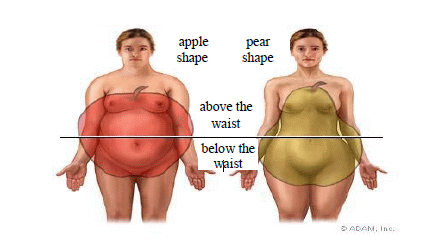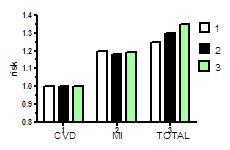VII.12.B. Obesity
Obesity develops through the long-term imbalance between the consumed and the utilized energy.
The unconsumed energy is stored as adipose tissue.
The degree of weight gain caused by an excessive energy intake is influenced by genetic factors. Some definitions are presented in Table 7.
|
BMI |
WHO |
Usual |
|
|
term |
term |
|
<18.5 kg/m2 |
underweight |
thin |
|
18.5-24.9 kg/m2 |
normal |
normal weight |
|
25.0-29.9 kg/m2 |
overweight |
overweight |
|
30.0-39.9 kg/m2 |
obese |
obese |
|
>40 kg/m2 |
obese |
severely obese |
Table 7. The classification of body weight
Obesity frequently displays a familial character. Obesity in childhood occurs more often if both parents are obese. 10% of the children of thin parents are obese, but if one of the parents is overweight, 50% of the children are overweight. If both parents are obese, 80% of the children are overweight. Heritable obesity has been proved only in rats. In humans, the nutritional habits and lifestyle play an important role in the development of the condition.
In the USA, the probability of obesity increased from 14.5% in 1980 to 30.5% in 2000. 48.8% of Hungarians are obese. The greatest problem is obesity in childhood, because 50-85% of obese children remain obese in adulthood.
b) Methods for measurement of the degree of obesity
- BMI
- Skinfold thickness
- Densitometry
- CT
- MRI
- Electrical impedance testing.
- Waist-hip ratio
Abdominal obesity is characterized by an increase in the waist-hip ratio.
The normal range is up to 1 in men and up to 0.9 in women.
Normal range of hip circumference:
for men < 94 cm, for women < 80 cm.
c) Types of obesity
I. Types determined by the development time:
Lifelong obesity
The birth weight is normal, but the weight gain starts in childhood. The process speeds up in puberty. The process often starts after birth among women. This type is characterized by an equable fat distribution, and an increase in the number of adipocytes.
Adult obesity
The development begins at 20-30 years of age. It is characterized by a moderate weight gain in the trunk. In adulthood, the body oxygen uptake decreases and the energy consumption decreases in parallel, and obesity develops through an unchanged calorie intake. This type is characterized by an increase in the adipocyte volume.
II. Types by the parts of the body
- gynoid
- peripheral
- lower body obesity (buttocks and thighs: gluteofemoral)
- subcutaneous
- pear shape
- typically in women
- induces varicose vein and joint diseases,
- android
- central,
- upper body obesity (visceral, abdominal)
- apple shape
- typically in men
The android type is more dangerous from the aspect of CVDs (Fig. 29).

Figure 29. The types of obesity
d) The process of obesity
First there is a gain in body weight
- parasympathetic predominance,
- increased function of gastrointestinal organs,
- energy storage.
This is followed by changes in the fat-muscle ratio
- the muscle mass decreases, the fat mass increases, the respiration worsens, and the central fat mass increases,
- the venous circulation worsens,
- the cardiac pump function worsens,
- the insulin resistance increases, and hyperinsulinemia develops,
- the FFA level increases,
- the ACTH production increases,
- the GH production decreases,
- the progesterone and testosterone production decreases,
- hyperlipidemia develops
the Apo-B and VLD levels increase, and the HDL level decreases, - the BP increases,
- coagulation disorders develop,
- apnea develops,
- musculoskeletal disorders develop.
d) Categories of obesity
- Primary obesity:
- Genetic causes: leptin resistance
- (hypothalamic appetite-suppressant effect)
- Increased food intake
- Physical inactivity
- Psychological causes: stress, solitude, etc.
- Genetic causes: leptin resistance
- Secondary obesity:
- Satiety signal disorders
- Regulatory roles of glucosamine
- Other adipogenous factors
- Fat storage – constitutional types
- Endocrine disorders: Cushing’s syndrome, hypothyroidism, insulinoma, lack of testosterone (in men)
- Central obesity: brain tumor (hypothalamus-pituitary), surgery
f) Complications of obesity
(BMI 35 – 40)
DM 3
dyslipidemia 2
arthritis (hyperuricemia), 2.5
high BP (hypertension) 2.9
gallstones, 2
colon cancer 1.3
ischemic heart diseases 1.9
stroke 3.1
atherosclerosis 2
g) Abdominal obesity as a risk factor for cardiovascular diseases

Figure 30. The relationships between waist circumference (WC) and the risk of fatal cardiovascular events.
1: WC men <95 cm, women <87 cm
2: WC men 96-103 cm, women <87-98 cm
3: WC men >103 cm, women >98 cm
(Dagenais GR, Yi Q, Mann JF, Bosch J, Pogue J, Yusuf S. Prognostic impact of body weight and abdominal obesity in women and men with cardiovascular disease. Am Heart J. 2005;149:54-60.)
h) Direct effects of obesity:
Obesity is an extra burden on the heart:
- The increased body weight requires more blood supply.
- The blood supply of the increased fat mass needs a larger blood volume and
a dense network of blood vessels because of the larger fat mass and increased peripheral vessel resistance and hence hypertension develops.
Hypertension and insulin resistance lead to:
the cellular Na+ and Ca2+ contents ↓,
the vascular smooth muscle contraction ↑,
the peripheral resistance ↑, and hence the hypertension ↑ further,
the TG level ↑,
the LDL cholesterol level ↑,
the HDL cholesterol concentration ↓.
i) Bulimia nervosa (BN)
The symptoms:
frequent episodes of binge eating,
manipulations to achieve a weight loss,
(vomiting, use of laxatives and diuretics),
worrying about body weight and shape,
two bouts of overeating per week.
BN is 3 times as frequent as AN: on average it affects 26 persons per 100,000 per year.
AN is typical at 12-18 years of age, whereas BN is typical mainly at 17-25 years of age.
One of the greatest problems of BN is that 80% of the patients do not receive medication because of the lack of recognition of the disease or the shame. The disease gradually spreads and is now becoming a worldwide problem.